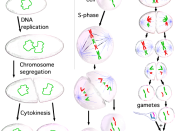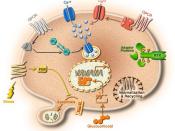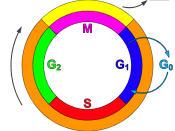BIOLOGY 1A06 ASSIGNMENT
HYPERCELL
CELL DIVISION
EDWIN MUJICA
LAB SECTION # 18
LAB DAY: FRIDAY
JANUARY 13, 1997
1. Where are the checkpoints in the cell division cycle and what are they called?
The cell division cycle consists of the reproduction of a pair of two daughter cells that are genetically identical. For this to occur, DNA must be duplicated and its products segregated into the nuclear spaces of the two daughter cells.
The cell cycle has four phases:
1. S Phase; Where chromosomes duplicate.
2. M phase: chromosome segregation sequence occurs.
These two phases are separated by two gap phases or periods of growth;
3. G1 phase, which occurs at the beginning of the cycle after M phase,
4. G2 phase, which occurs before M phase.
The cell Cycle processes are regulated by a series of multipurpose controls called check points. There are three different checkpoint in the cell cycle:
a. Check point G1, Is also called START (in yeast ) or restriction point ( in mammals). This checkpoint occurs near the end of the G1 phase.
b. Checkpoint G2, which occurs at the end of G2 phase.
c. Check point Metaphase, which occurs at the end of the M phase.
2. For each checkpoint, what conditions are monitored?
At each checkpoint, information about the status of the cell and environment are monitored to determine whether or not the cell cycle control system can continue. If cell size and the environment conditions are favorable in the G1 checkpoint (START or Restriction point), the DNA replication machinery is triggered and the control system moves forward. Similarly for the G2 checkpoint, if the size of the cell, the environment conditions as well as the fact that DNA replication is complete are favorable, the mitosis machinery is triggered and the cycle continues.


